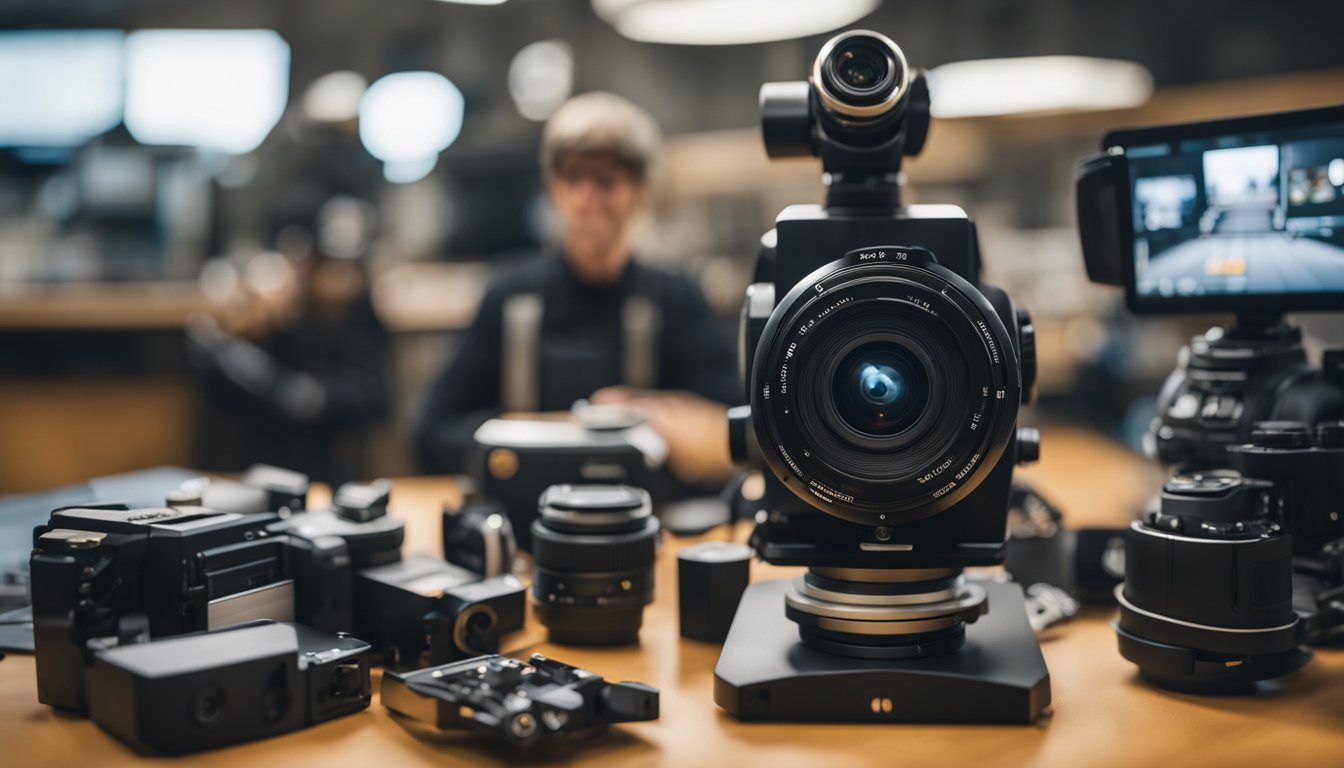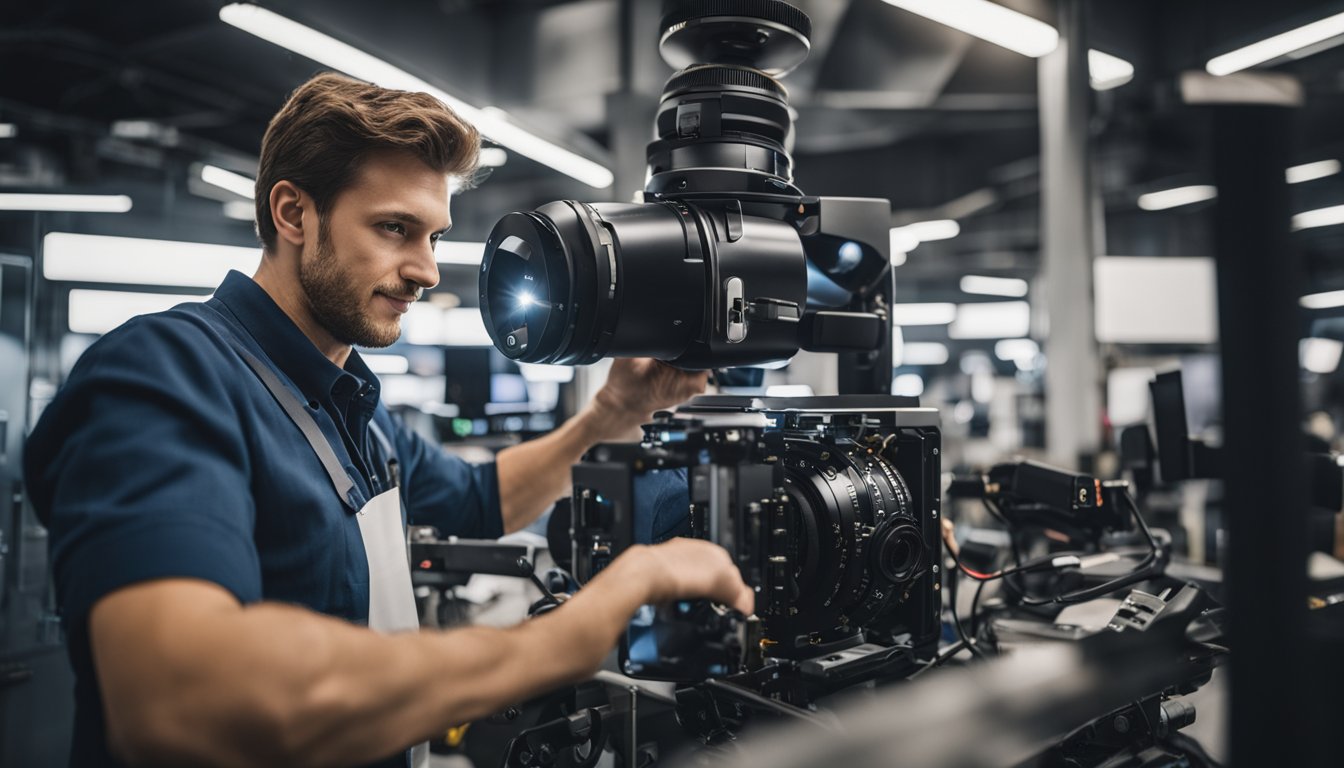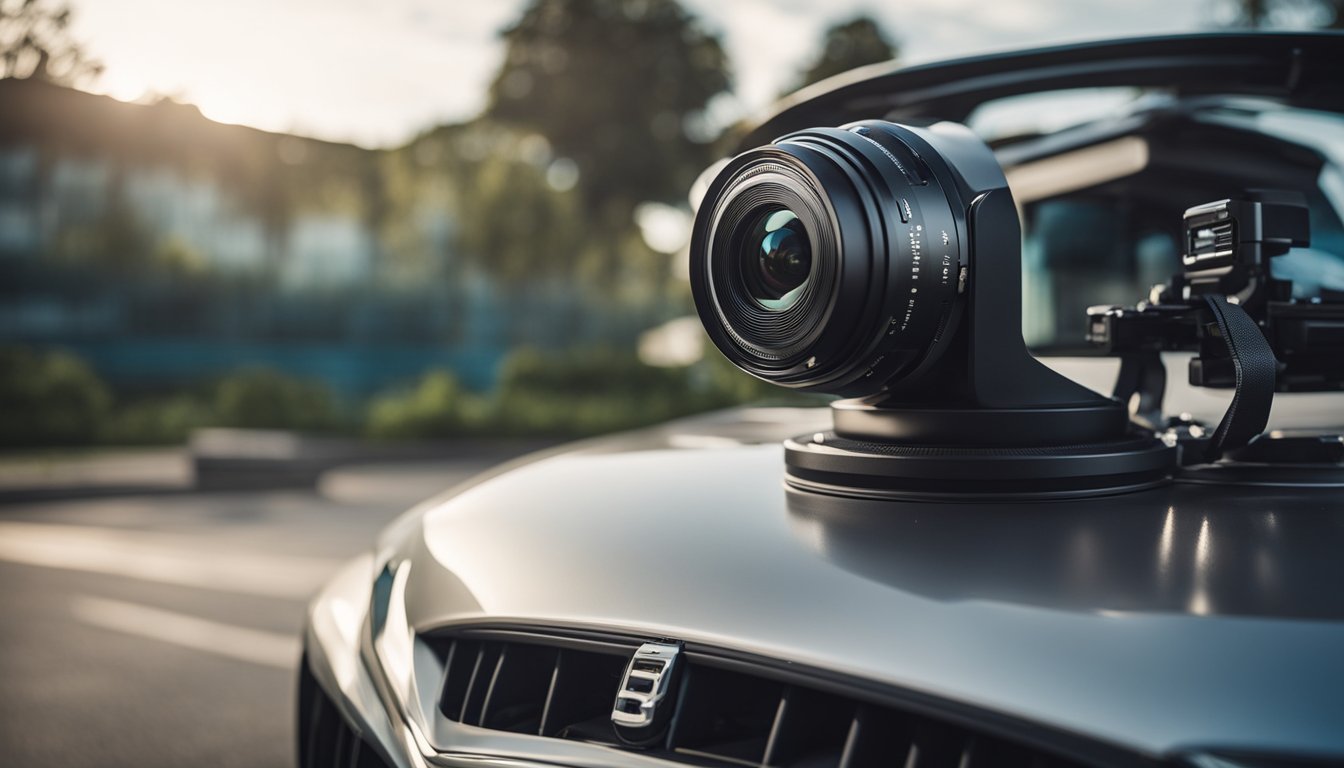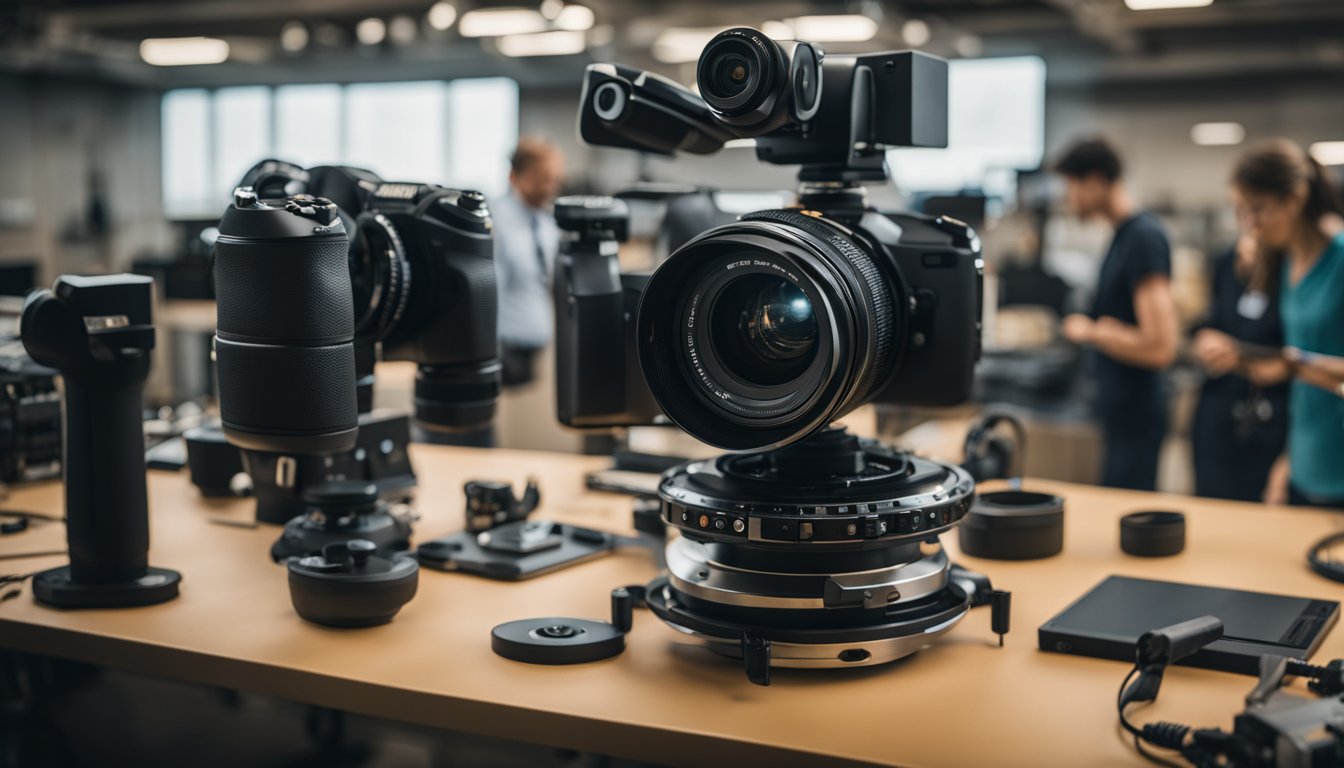360-degree camera systems are becoming increasingly popular among car enthusiasts. These cameras provide a bird’s-eye view of the vehicle and its surroundings, making parking and maneuvering in tight spaces much easier. If you’re considering retrofitting a 360-degree camera to your car, you may be wondering if it’s possible and what the process entails.

The good news is that retrofitting a 360-degree camera to your car is possible, but the process can be complex and expensive. It’s important to understand the different types of 360-degree camera systems available, as well as the compatibility of your vehicle and the cost considerations involved. Additionally, technical support and troubleshooting may be required during the installation process.
Key Takeaways
- Retrofitting a 360-degree camera to your car is possible but can be complex and expensive.
- Understanding the different types of 360-degree camera systems available, vehicle compatibility, and cost considerations is important.
- Technical support and troubleshooting may be required during the installation process.
Understanding 360-Degree Camera Systems
https://www.youtube.com/watch?v=xqWkJJOcU4g&embed=true
If you’re considering retrofitting your car with a 360-degree camera system, it’s important to understand how these systems work and what benefits they offer. In this section, we’ll explore the components of a camera system and how 360 cameras enhance parking assistance.
Components of a Camera System
A 360-degree camera system typically consists of multiple cameras placed around the car to provide a complete view of the vehicle’s surroundings. These cameras capture video footage, which is then stitched together to create a seamless 360-degree view. The resulting image is displayed on a monitor inside the car, giving you a real-time view of your surroundings.
In addition to cameras, 360-degree camera systems often include parking sensors or proximity sensors. These sensors detect obstacles and provide an audible or visual warning to the driver. Some systems also include automatic braking or steering assistance to help avoid collisions.

How 360 Cameras Enhance Parking Assistance
One of the primary benefits of a 360-degree camera system is enhanced parking assistance. With a 360-degree view of your surroundings, you can more easily navigate tight parking spaces and avoid obstacles. The system provides a clear view of the area around your car, making it easier to judge distances and avoid collisions.
In addition to parking assistance, 360-degree camera systems can also enhance safety on the road. By providing a complete view of your surroundings, these systems can help you avoid collisions with other vehicles, pedestrians, and obstacles.
Overall, a 360-degree camera system can be a valuable addition to your car, providing enhanced safety and convenience. If you’re considering retrofitting your car with a camera system, be sure to choose a reputable installer and select a system that meets your specific needs.
The Retrofitting Process
https://www.youtube.com/watch?v=FiCmbPZcAJw&embed=true
If you’re looking to retrofit a 360-degree camera onto your vehicle, there are a few things you should know. First and foremost, you’ll need to assess the feasibility of the retrofitting process. Once you’ve determined that it’s possible, you’ll need to choose the right 360 camera kit for your vehicle.
Feasibility Assessment
« Vehicles with 360 Camera: A Comprehensive Guide to the Latest Models
Electric Cars with 360 Camera: A Comprehensive Guide to the Latest Features and Benefits »
Before you start the retrofitting process, you’ll need to assess whether it’s feasible for your vehicle. You’ll need to determine if your vehicle has the necessary wiring and connectors to support a 360-degree camera. If your vehicle doesn’t have the necessary wiring, you’ll need to install a harness and cables to support the camera.
It’s also important to note that retrofitting a 360-degree camera can be a complex process. You’ll need to have a good understanding of your vehicle’s electrical system and be comfortable working with wiring and connectors. If you’re not comfortable with this type of work, it’s best to leave it to a professional.
Choosing the Right 360 Camera Kit
Once you’ve determined that retrofitting a 360-degree camera is feasible for your vehicle, you’ll need to choose the right camera kit. There are many aftermarket 360-degree camera kits available, so it’s important to choose one that’s compatible with your vehicle.
When choosing a camera kit, look for one that’s designed specifically for your make and model of vehicle. This will ensure that the kit includes all of the necessary components and that it’s easy to install. You should also consider the quality of the camera and the features that it offers.
In conclusion, retrofitting a 360-degree camera onto your vehicle can be a complex process, but it’s possible with the right tools and knowledge. Assess the feasibility of the process, choose the right camera kit, and be prepared to work with wiring and connectors. With a little bit of patience and effort, you can enjoy the benefits of a 360-degree camera on your vehicle.
Vehicle Compatibility
When it comes to retrofitting a 360-degree camera to your vehicle, compatibility is a major concern. Not all vehicles are compatible with this technology, and some may require extensive modifications to make it work. In this section, we’ll discuss the vehicle compatibility of 360-degree cameras and what you need to know before installing one in your car.
Common Compatible Brands
Many popular car brands such as Toyota, Ford, Kia, Audi, BMW, Land Rover, Mercedes, Hyundai, Volvo, Mercedes-Benz, Chevrolet, and Honda offer 360-degree cameras as standard or optional equipment on some of their models. However, not all models within these brands will have this feature, so it’s important to check your vehicle’s specifications before attempting to retrofit a 360-degree camera.
Understanding Electrical Systems
One of the biggest challenges of retrofitting a 360-degree camera is understanding the electrical systems of your vehicle. Installing a 360-degree camera requires tapping into your car’s electrical system, which can be complex and difficult to navigate. If you’re not familiar with electronics and electrical systems, it’s best to seek professional help.
It’s also worth noting that some vehicles may require additional wiring or modifications to support a 360-degree camera. For example, SUVs may need additional wiring to connect the cameras to the car’s display screen. It’s important to research your specific vehicle and the requirements for retrofitting a 360-degree camera before attempting the installation.
In conclusion, retrofitting a 360-degree camera to your vehicle can be a great way to improve safety and convenience while driving. However, it’s essential to ensure your vehicle is compatible with this technology and to understand the electrical systems before attempting to install one. If you’re unsure about the installation process or don’t have experience with electronics, it’s best to seek professional help.
Installation Guide
https://www.youtube.com/watch?v=QsI4puDWVzw&embed=true
If you’re interested in retrofitting a 360-degree camera to your vehicle, it’s important to understand the installation process. Here’s a brief guide to help you get started.
Mounting the Cameras
The first step in installing a 360-degree camera is to mount the cameras in the appropriate locations. This typically involves mounting a camera at the front of the vehicle, a camera at the rear of the vehicle, and two cameras on the side mirrors. The cameras should be mounted in a way that provides a clear view of the surrounding area.
When mounting the cameras, it’s important to ensure that they are securely attached to the vehicle. This may involve drilling holes in the bumper or other parts of the vehicle. If you’re not comfortable with drilling holes in your vehicle, it’s best to have a professional install the cameras for you.
Wiring and Connection
Once the cameras are mounted, the next step is to connect them to the vehicle’s electrical system. This typically involves running cables from the cameras to a control unit, which is then connected to the vehicle’s display screen.
When running the cables, it’s important to ensure that they are hidden from view and protected from damage. This may involve running the cables through the vehicle’s interior or under the vehicle’s body.
Once the cables are connected, you’ll need to test the system to ensure that everything is working properly. This may involve adjusting the camera angles or making other adjustments to ensure that you have a clear view of the surrounding area.
Overall, retrofitting a 360-degree camera to your vehicle can be a challenging but rewarding project. With the right tools and a little bit of patience, you can enjoy the benefits of a 360-degree camera without having to purchase a new vehicle.
Integration with Vehicle Systems
https://www.youtube.com/watch?v=RXjypmi9FQQ&embed=true
When retrofitting a 360-degree camera system to your car, it’s important to consider how it will integrate with your vehicle’s existing systems. Two key areas to consider are connecting to in-car displays and software configuration.
Connecting to In-Car Displays
Most modern cars come with a built-in infotainment system that includes a display screen. If you’re retrofitting a 360-degree camera system, you’ll want to make sure that it can be connected to your car’s display. Some aftermarket camera systems come with their own display, while others can be integrated with your car’s existing screen.
If you’re integrating with your car’s existing screen, you’ll want to make sure that it’s compatible with the camera system you’re installing. Some camera systems may require additional hardware or software to connect to your car’s display, so it’s important to do your research before making a purchase.
Software Configuration
Once you’ve connected your camera system to your car’s display, you’ll need to configure the software to work with your vehicle. This may involve installing new software or updating your car’s existing software to support the camera system.
Some camera systems may require over-the-air (OTA) updates to ensure that they’re working properly with your car’s software. If you’re not comfortable with updating your car’s software, it’s best to consult with a professional installer to ensure that everything is set up correctly.
It’s also important to consider how the camera system will integrate with your car’s navigation system. Some camera systems may be able to display navigation information on the camera feed, while others may require separate displays.
Overall, retrofitting a 360-degree camera system to your car can be a great way to improve your driving experience. Just make sure to do your research and work with a professional installer to ensure that everything is set up correctly.
Cost Considerations
When considering retrofitting a 360-degree camera to your vehicle, cost is an important factor to consider. This section will help you understand the budgeting process and the price range of kits available.
Budgeting for Retrofitting
Before you decide to retrofit a 360-degree camera to your vehicle, it is important to consider your budget. The cost of retrofitting a 360-degree camera can vary depending on several factors, including the type of camera, the make and model of your vehicle, and the complexity of the installation.
When budgeting for retrofitting, it is important to consider the cost of the camera kit, installation fees, and any additional equipment or accessories you may need. You may also want to consider the potential increase in your vehicle’s resale value after the installation.
Price Range of Kits
The price range of 360-degree camera kits can vary widely depending on the brand, quality, and features of the kit. On average, you can expect to spend anywhere from $300 to $1,200 for a complete kit. However, prices can escalate for luxury models or if additional features are incorporated.
When shopping for a kit, it is important to compare prices and features to find the best value for your budget. You may also want to consider purchasing a kit from a reputable brand to ensure quality and reliability.
Overall, retrofitting a 360-degree camera to your vehicle can be a worthwhile investment for safety and convenience. By budgeting carefully and comparing prices, you can find a kit that fits your needs and your budget.
Technical Support and Troubleshooting
If you encounter any issues while retrofitting a 360-degree camera, there are several resources available to help you troubleshoot the problem. In this section, we will discuss the two main types of support available: online resources and professional assistance.
Online Resources
One of the most convenient and accessible sources of technical support is online forums. You can find forums dedicated to almost any topic, including retrofitting 360-degree cameras. These forums are a great place to ask questions, share your experiences, and get advice from other enthusiasts who have already completed similar projects. Some popular forums include F150Gen14 and Ford F150 Forum.
In addition to forums, you can also find technical support through the manufacturer’s website or through third-party websites that specialize in aftermarket upgrades. For example, BimmerTech offers technical support for their surround view retrofit kit, which allows you to add a 360-degree camera to your BMW.
Professional Assistance
If you encounter a problem that you can’t solve on your own, you may need to seek professional assistance. This could include taking your vehicle to a mechanic or contacting the manufacturer’s technical support team. Many manufacturers offer technical support over the phone or through email, which can be a convenient way to get help without having to leave your home.
If you decide to take your vehicle to a mechanic, be sure to choose someone who has experience with retrofitting 360-degree cameras. You can ask for recommendations from other enthusiasts on forums or through social media groups. It’s also a good idea to check the mechanic’s credentials and read reviews from other customers to ensure that you’re getting quality service.
In conclusion, retrofitting a 360-degree camera can be a challenging project, but with the right resources and support, you can successfully complete the installation. Whether you rely on online forums or seek professional assistance, there are many options available to help you troubleshoot any issues that arise.
Enhancements and Upgrades
https://www.youtube.com/watch?v=83stPzRNwTc&embed=true
If you’re looking to upgrade your car’s camera system, you have two options: upgrade to a higher trim level or add advanced features to your current system. Here are some things to consider when making your decision.
Upgrading to a Higher Trim Level
If you’re interested in upgrading to a higher trim level, you may be able to get a 360-degree camera system as part of the package. This will likely include other features such as parking assistance, a surround view system, and OTA updates. Keep in mind that upgrading to a higher trim level can be expensive, and you may not need all of the features that come with it.
Adding Advanced Features
If you’re happy with your current trim level but want to add advanced features to your camera system, there are a few options available to you. One option is to use an app on your phone to control and view your camera system. Another option is to add a phone holder to your car so that you can use your phone as a display for your camera system.
You can also add advanced features such as parking assistance and a surround view system to your current camera system. This will likely require some additional hardware and software, but it can be a cost-effective way to get the features you want without upgrading to a higher trim level.
Overall, upgrading your camera system can be a great way to improve your driving experience and increase your safety on the road. Whether you choose to upgrade to a higher trim level or add advanced features to your current system, make sure to do your research and choose the option that best fits your needs and budget.
Legal and Safety Considerations
When considering retrofitting a 360-degree camera to your vehicle, it’s important to keep in mind the legal and safety considerations involved. Here are some key points to keep in mind:
Compliance with Regulations
First and foremost, you need to ensure that any retrofit you perform is in compliance with all relevant regulations. This includes both federal and state regulations, which can vary depending on where you live. Failure to comply with these regulations can result in fines or other legal consequences.
Impact on Vehicle Safety
Another important consideration is the impact that retrofitting a 360-degree camera could have on your vehicle’s safety. While a properly installed camera can provide additional visibility and help prevent accidents, a poorly installed or malfunctioning camera could actually make your vehicle less safe. It’s important to ensure that any retrofit is done by a qualified professional and that the camera is properly calibrated to ensure accurate and reliable performance.
In addition to these legal and safety considerations, it’s also important to keep in mind the security implications of retrofitting a 360-degree camera. While the camera itself is unlikely to pose a security risk, it’s important to ensure that any data collected by the camera is stored securely and protected from unauthorized access.
Overall, retrofitting a 360-degree camera to your vehicle can be a great way to improve visibility and safety. However, it’s important to make sure that you’re complying with all relevant regulations, working with a qualified professional, and taking steps to ensure the security of any data collected by the camera.
User Experience
https://www.youtube.com/watch?v=tlLUeF9TRn4&embed=true
Interacting with the System
When you retrofit a 360-degree camera system to your vehicle, you will be able to interact with the system through the car’s dashboard. The system provides you with a bird’s eye view of your vehicle, making it easier for you to maneuver in tight spaces. The dashboard displays the top view of your car, which gives you a clear view of your surroundings, including parking spaces and other vehicles.
The system also provides you with a real-time view of your car’s surroundings, which is especially helpful when you are backing up or trying to park in a tight spot. This feature can be particularly useful in cities where parking spaces are limited. The system also displays a visual warning on the dashboard when you are too close to an object, making it easier for you to avoid accidents.
Real-World Applications
Retrofitting a 360-degree camera system to your car can be beneficial in many real-world applications. For example, if you live in a city where parking is scarce, the system can help you find a parking space easily. The system can also help you avoid accidents when you are backing up or parallel parking.
The system can also be useful when you are driving on the highway. The bird’s eye view of your car’s surroundings can help you avoid accidents by providing you with an early warning of any potential hazards. The system can also be helpful when you are driving in tight spaces, such as parking garages or narrow streets.
In conclusion, retrofitting a 360-degree camera system to your car can greatly improve your driving experience. The system provides you with a bird’s eye view of your car’s surroundings, making it easier for you to maneuver in tight spaces. The system also provides you with a real-time view of your car’s surroundings, which can be helpful in avoiding accidents.
Product Reviews and Recommendations
Analyzing Consumer Feedback
Before you decide to retrofit your camera with a 360-degree lens, it’s important to look at consumer feedback. This can help you determine which retrofit kits are worth investing in and which ones to avoid.
Based on reviews from various online retailers, it appears that many consumers have had success retrofitting their cameras with 360-degree lenses. However, it’s important to note that the success of a retrofit kit will depend on the specific camera model you have and the quality of the kit you purchase.
Some consumers have reported issues with image quality after retrofitting their cameras, while others have had trouble with the installation process. It’s important to read reviews carefully and look for kits that have positive feedback from consumers who have a similar camera model as yours.
Top Picks for Retrofit Kits
If you’re interested in retrofitting your camera with a 360-degree lens, there are a few top picks to consider. These kits have received positive feedback from consumers and are known for their quality and ease of use.
-
Insta360 Nano: This retrofit kit is designed for iPhone users and allows you to capture 360-degree photos and videos directly from your phone. It’s easy to use and produces high-quality images.
-
Ricoh Theta V: This 360-degree camera is a great option if you’re looking for a standalone device. It’s compact and easy to use, and produces high-quality images and videos.
-
GoPro Fusion: If you already own a GoPro camera, the Fusion retrofit kit is a great option. It’s easy to install and produces high-quality 360-degree images and videos.
When choosing a retrofit kit, it’s important to consider the specific features you’re looking for. Some kits may be better suited for certain camera models or types of photography, so be sure to do your research before making a purchase.
Frequently Asked Questions
https://www.youtube.com/watch?v=Od5eoiF0O1s&embed=true
What are the best aftermarket 360-degree cameras for cars?
There are many aftermarket 360-degree camera systems available in the market. Some of the best options include the Garmin BC 30 Wireless Backup Camera, the Auto-Vox X1 Mirror Dash Cam, and the iStrong Digital Wireless Backup Camera.
How do you install a 360-degree camera system in a vehicle?
The installation process of a 360-degree camera system varies depending on the make and model of your car. However, most systems require mounting the cameras on the exterior of the car and running wires to the display unit. It is recommended that you hire a professional to install the system to ensure proper installation and avoid any damage to your car.
Can you upgrade an F150 with a 360-degree camera?
Yes, it is possible to retrofit an F150 with a 360-degree camera system. However, the process can be expensive and time-consuming. It is recommended that you consult a professional installer to determine the feasibility of the retrofit and to get an accurate estimate of the cost.
Are aftermarket 360-degree camera systems compatible with all car models?
No, not all aftermarket 360-degree camera systems are compatible with all car models. It is important to check the compatibility of the system with your car before making a purchase. You can consult the manufacturer’s website or contact their customer support for more information.
What benefits do 360-degree cameras provide for car racing?
360-degree cameras provide a variety of benefits for car racing, including improved visibility, enhanced safety, and better situational awareness. They can help drivers avoid collisions, navigate tight turns, and make more informed decisions on the track.
Which vehicles come with a built-in 360-degree camera?
Many luxury car manufacturers offer built-in 360-degree camera systems as standard or optional features. Some of the popular cars with built-in 360-degree cameras include the BMW 7 Series, Mercedes-Benz S-Class, and Audi Q7. However, the availability of this feature may vary depending on the trim level and model year of the car.











